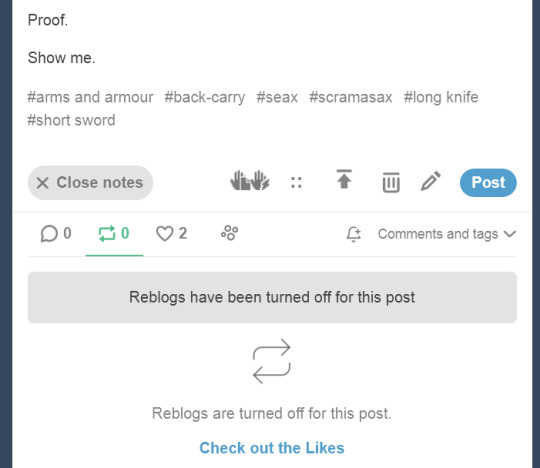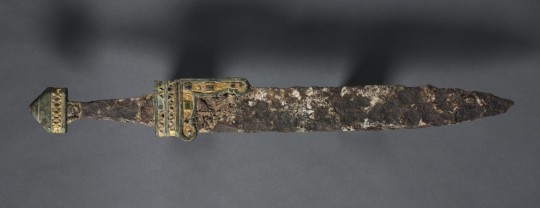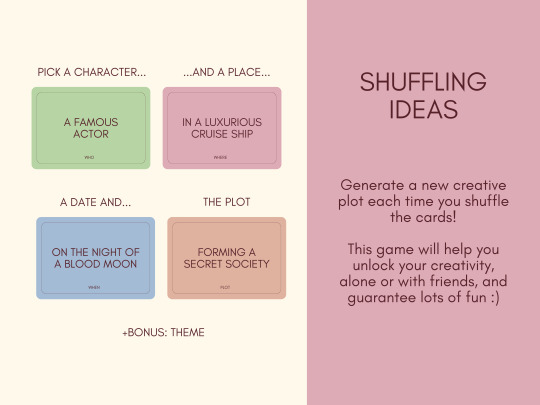#research
Text
@nimblermortal sent me this last week:
A second blade weapon became increasingly common in the later Viking Age. It does not have a formal name, being often referred to as a fighting-knife or battle-knife, and it was essentially a development of the one-handed, long seax knife of the Migration Period. A single-edged blade with a thick back that added weight to a short, stabbing blow, it seems to have been intended as a back-up weapon. By the tenth century, battle-knives had elaborate scabbards that were worn horizontally along the belt, allowing them to be drawn across the body from behind a shield if the sword was gone; a variant hung down at an angle from an elaborate harness. It seems they may also have been worn on the back - again for a swift, over-the-shoulder draw.
Children of Ash and Elm by Neil Price
@petermorwood (Mr Morwood! Mr Morwood!) I found an archaeologist claiming people were doing over-the-shoulder draws! Would you care to weigh in?
*****
Would I ever! That's a button well pushed. But things got odd when I tried, because as soon as I'd written even the smallest reply and saved to Draft, this happened:


Letting it stand would have seemed like I was trying to avoid comments, corrections or criticism, but despite poking around in Settings there was no way to turn things on. It was only by cut-and-pasting @nimblermortal's entire original as a Quote starting a new post that the problem was resolved.
Anyone else encountered this?
Anyway, on with the lecture response. :->
*****
As regards Back-Carry / Back-Draw of "battle-knives", I'm not convinced.
("Battle-knife" is a term I've never seen in connection with any Viking Age weapon. What's the Old Norse for it? German "Kriegsmesser" (war-knife) refers to something much bigger from 500 years later, also not back-carried or back-drawn - which from here on will be BD / BC.)
To get where he is now, a full professor, Neil Price will have defended his PhD, and should know such a statement as "It seems they may..." will need evidence to support it.
That phrase is easy to write, as is "According to legend..." and "It is said..." However these are IMO default History Channel phrases, with all the authenticity that implies. None of them actually PROVE what they're speculating.
"Experiments conducted by museum staff wearing authentic armour reveal that IT SEEMS medieval knights could use smartphones."
But does it prove medieval knights USED smartphones? See what I mean?
*****
I first asked if anyone had actual proof of BC / BD on Netsword almost 30 years ago, and to date there's been nothing. I've also posted about it quite a lot on Tumblr, so being poked with this particular stick is no surprise. :->
The quotation from "Children of Ash and Elm" is the first time I've heard of a trained archaeologist making a claim for BC / BD, and the odd part is that Prof. Price also states the weapon was intended for "...a short, stabbing blow" - which means wearing it horizontally in front makes far more sense. From that position it can be drawn far faster and with less telegraphed intent than "...on the back - again for a swift, over-the-shoulder draw."
Reaching up for any weapon carried across the back, whether long or short, is a bigger movement - and thus less "swift" - than snatching out the same weapon worn at the hip or across the front at waist level, especially if - as he suggests - that move is masked behind a shield (or for that matter a cloak, a door, or a half-turned torso...)
Try both moves in front of a mirror with a ruler or even a length of dowel, and you'll understand.
With a weapon-hilt visible behind one shoulder or just a cross-belt suggesting something slung out of sight, what's a Norse warrior going to think when his potential opponent reaches up there? At a moment of hot words and high tension, will he wait while an itchy back gets scratched or until an attack happens?
The explosive violence described in sagas suggests not.
If Prof. Price has solid proof for his BC / BD notion in the form of artefacts or art - and it'll need more than a one-off example - I'll be very pleased to finally see some "show me" evidence.
(It won't do anything for longswords of 500 years later, of course, though I bet the uncritical back-carry brigade would leap on it regardless.)
But without that evidence, I'm taking "it seems" with a wary pinch of salt.
*****
There's a weird internet fixation about BC / BD (which are NOT the same thing) and an equally weird need to show that back-draw "works", whether with hooks under the guard and a leather condom at the point...

... or by being open most of the way down one side.

Neither are real-world historical, so let's see how they work in fantasy.
IMO they're not appropriate there either, because the designers are so eager to provide working BC / BD that they ignore the main function of a scabbard, which is to carry the weapon in something which protects people from the weapon's edges, and the weapon from the elements.
Real scabbards for real swords went to some trouble over that. They protected people, including the wearer, with a completely enclosed wooden, leather and / or metal case, and protected the blades by having them fit into their case well enough that inclement weather stayed out.
This fitting could involve metal collars (Japanese habaki), or tight-gripping lanolin-rich fleece linings, or leather flaps, caps and rain-guards mounted on hilt or scabbard-throat. Real scabbards didn't have exposed metal and weren't open-sided rainfall buckets, because the priorities of actual sword users were very different to those of back-carry fans.
Given the number of posts I've seen about the technical side of fantasy world-building - history, geography, even geology and meteorology - I think this difference is worth noting.
*****
The first time I recall seeing back-carry mentioned in a historical-not-fantasy context was in "Growing Up in the Thirteenth Century", © Alfred Duggan 1962. Here's the extract in question:

Unfortunately Duggan - though according to his Wikipedia entry "His novels are known for meticulous historical research" - doesn't give any cited source for this; his introduction to the book says:

I know the feeling! :->
I'd still trust him more than some modern historical writers who seem over-willing to add a touch of fantasy speculation / interpretation if it rounds out something inconclusive, makes the history more interesting or chimes with a personal agenda.
"Accurate" is better than "interesting", and "I don't know" is better than making stuff up.
*****
To repeat: I've yet to see any museum-exhibit or manuscript-illumination examples of BC / BD ever done For Historically Real with Western European swords, especially the hand-and-a-half longswords on which modern back-draw fans seem fixated.
A seax, scramasax or just plan sax is shorter, but yet again, this is the first time I've read anything even remotely scholarly about them or their later Viking-age version (saxes were associated more with Saxons than Vikings, guess why?) being BC / BD.
By contrast, there are at least three art instances of saxes worn horizontally, on 10th century crosses at Middleton Church, Yorkshire:



The art is backed up by surviving examples with scabbard-fittings still in place, indicating how they were worn. Here's one example, from the Metropolitan Museum, New York which makes that very obvious.

The little decorative masks (originally part of the top of the scabbard, now corroded onto the blade) are clearly meant to be This Side Up, and also show that this scabbard was This Side Out for a right-handed draw, since there's no detail on the back.

There's a similar fancy-front / plain-back / right-hand-use leather sax scabbard at the Jorvik Centre in York.
There's only a single photograph of this bigger one - 54cm (21.5 in) overall - from the Cleveland Museum of Art, with no way to see if the L-shaped scabbard mount is decorated on just one or both sides. However it does indicate the weapon was meant for horizontal wear.

I've also flipped the website photo to show right-hand use, because "It seems..." (hah!) more probable. Here's why I did it:
For most of history being left-handed was unusual, a disapproved-of aberration and the origin of the word sinister.
Left-handers were useless in any formation from Ancient Greece through Ancient Rome to the Saxon and Viking period where the shields of a phalanx, testudo or shield-wall had to overlap for mutual support.
In the Middle Ages, both the specialised armour and the layout of jousting courses were almost 100% right-hand only.
Most surviving swords with asymmetrical hilts, such as swept-hilt rapiers, are made to for right hands not left.
Even nowadays many weapons - including the current British Army rifle (SA-80 / L85/A2) - are set for right-handers only.
*****
The longest saxes are called Langseax (surprise) though this may be a modern-ish term. Here's one from the British Museum, the so-called "Seax of Beagnoth"...

...which is 72 cm (28.5 in) total / 55cm (22 in) blade.
That's about the same as a Roman gladius (another sword never back-worn despite its convenient size) and is a good 25-30cm (10-12 in) shorter than the average "proper" sword of the same period, which means it could be drawn over-shoulder...
However the layout of its runic engraving shows it was almost certainly meant to be worn horizontally As Per Usual.
*****
And now we've come all the way back around to Prof. Price's claim that Vikings did BC / BD with their battle-knives.
Such a claim needs proof.
Please, show me some.
#arms and armour#back-carry#seax#scramasax#long knife#short sword#left-handed weapons#research#evidence
60 notes
·
View notes
Text
#mcelroys#the matrix#self healing#911 fox#tv#toji smut#research#wattpad#trevor belmont#six of crows#cyborg#perfect wife#Aimi Yoshikawa#xbox#bnha x reader
122 notes
·
View notes
Text
Shuffling Ideas - a free game for writers
Hello hello, it's me, Rach! And today I’m bringing another... FREEBIE!

Are you looking for fun ways to brainstorm ideas? I have the solution right here (and it's free!)
Shuffling Ideas is a creative card game designed to be versatile and can be enjoyed both solo and in a group setting. When playing solo, you can use the cards to challenge your creativity, overcome writer’s block, or simply have fun concocting new and exciting plots. It’s a fun way to practice your writing skills and let your imagination run wild with over 1 million different plot combinations at your disposal. So, whether you’re in the mood for some quiet writing time or looking to brainstorm story ideas, Shuffling Ideas is the perfect go-to.
You’ll receive a PDF file ready for download, ensuring instant access to the game. No waiting, no shipping fees!
With 22 pages of content, you have the flexibility to print only the 10 pages required for the card fronts, saving you ink and paper
Over 1 million different plot combinations are possible, ensuring that no two writing sessions are ever the same.
So, if you're ready to have fun while unlocking your creative side, grab your freebie now and get started!
Oh, and don’t forget to tag your creative buddies who would love this and spread the word!
Get it here!!
#freebie#free#card game#writing resources#writing#writeblr#writer tips#writing advice#writing help#writing tips#poetsandwriters#resources#research#wattpad#nanowrimo#creative writing#writerscommunity#writers#writing inspiration#writing prompts#writing reference#writerslife#writersofinstagram#software#inspiration#writing inspo#for writing#for writers#for whoever needs it#useful resources
46 notes
·
View notes
Text
A lot of people enjoyed doing the questionnaire for my dissertation so I have another! This one is looking at key Dan and Phil things and their impact on mental health and how important they are to you.
This is for the parasocial study side of my dissertation :)
Its anonymous
#form#questionnaire#research#dan and phil#dip and pip#phan#daniel howell#amazingphil#dan howell#phil lester#study#dissertation#please can people fill it out <3#its anonymous
24 notes
·
View notes
Text
DO NOT DO THIS!!!
If a website has a paywall, like New York Times, DO NOT use the ctrl+A shortcut then the ctrl+c shortcut as fast as you can because then you may accidentally copy the entire article before the paywall comes up. And definitely don't do ctrl+v into the next google doc or whatever you open because then you will accidentally paste the entire article into a google doc or something!!!! I repeat DO NOT do this because it is piracy which is absolutely totally wrong!!!
124K notes
·
View notes
Text
the cognitive dissonance from people who want the products of modern medicine but get weird about animal research. like im sorry but this is necessary for the survival of the society we currently live in. and the scientists who work on these things are not evil cackling psychopaths. anyone you talk to in animal research has incredibly complex feelings about their work and incredibly complex relationships to the animals in their care. there are regulations and oversight and penalties in place to make the work as humane as possible and scientists are overwhelmingly the ones enforcing and advocating for better care.
#i work with invertebrates so nobody cares about what i do but literally everybody else in my building does mice/dogs/primates#science#biology#research#animal testing
55K notes
·
View notes
Text
Horrible fact of the day: Chevron just released a new boat fuel that WILL give you cancer.
Not "might", not "could", WILL. It has a cancer ratio of 1.3:1, as in, in a group of 10 people, 10 would contract CANCER.
(Edit: apparently some articles are now saying 1.4:1, and some are saying a little under that. Either way, the consensus seems to be anywhere between a 95-100+% of contracting cancer, with some expectations of this fuel not even needing a full lifetime of exposure for you to get Cancer.)
The EPA's safety limit is 1:1,000,000 as in 1 in a million people get cancer.
The EPA approved it anyways. I am not joking. The EPA approved a boat fuel that has a near 100% chance of giving someone cancer. It has such a good chance of giving someone cancer that if you DIDN'T get cancer YOU WOULD BE AN OUTLIER.
Fuck the oil industries.
Edit: If you find this (rightfully) horrifying, have you considered industrial sabotage? /hj
This isn't something we can vote away. This isn't something the rich are gonna apologize and make a 10 minute apology video for this. They don't care if you starve or wither in hospitals or get blown up in their wars.
If you don't know where to get started:
If you already know what to do, then it's time to do it. Participate in mutual aid, raise awareness in real life as well as online, participate in or train in self defense and emergency medical training classes.
#anarchy#chevron#fuel#oil#news#health#healthcare#cancer#research#anarchism#leftism#anarchist#leftist#communist#socialism#socialist#eco#green#earth
33K notes
·
View notes
Text

In other news, JSTOR's new PDF viewer is here, designed to optimize your reading experience!
Learn more about the new changes.
15K notes
·
View notes
Text

So it turns out that ChatGPT not only uses a ton shit of energy, but also a ton shit of water. This is according to a new study by a group of researchers from the University of California Riverside and the University of Texas Arlington, Futurism reports.

Which sounds INSANE but also makes sense when you think of it. You know what happens to, for example, your computer when it’s doing a LOT of work and processing. You gotta cool those machines.

And what’s worrying about this is that water shortages are already an issue almost everywhere, and over this summer, and the next summers, will become more and more of a problem with the rising temperatures all over the world. So it’s important to have this in mind and share the info. Big part of how we ended up where we are with the climate crisis is that for a long time politicians KNEW about the science, but the large public didn’t have all the facts. We didn’t have access to it. KNOWING about things and sharing that info can be a real game-changer. Because then we know up to what point we, as individuals, can have effective actions in our daily lives and what we need to be asking our legislators for.
And with all the issues AI can pose, I think this is such an important argument to add to the conversation.
Edit: I previously accidentally typed Colorado instead of California. Thank you to the fellow user who noticed and signaled that!
#lem talks#let’s get political#science#science tumblr#politics#research#artificial intelligence#AI#climate#important
38K notes
·
View notes
Text
Skip Google for Research
As Google has worked to overtake the internet, its search algorithm has not just gotten worse. It has been designed to prioritize advertisers and popular pages often times excluding pages and content that better matches your search terms
As a writer in need of information for my stories, I find this unacceptable. As a proponent of availability of information so the populace can actually educate itself, it is unforgivable.
Below is a concise list of useful research sites compiled by Edward Clark over on Facebook. I was familiar with some, but not all of these.
⁂
Google is so powerful that it "hides" other search systems from us. We just don't know the existence of most of them. Meanwhile, there are still a huge number of excellent searchers in the world who specialize in books, science, other smart information. Keep a list of sites you never heard of.
www.refseek.com - Academic Resource Search. More than a billion sources: encyclopedia, monographies, magazines.
www.worldcat.org - a search for the contents of 20 thousand worldwide libraries. Find out where lies the nearest rare book you need.
https://link.springer.com - access to more than 10 million scientific documents: books, articles, research protocols.
www.bioline.org.br is a library of scientific bioscience journals published in developing countries.
http://repec.org - volunteers from 102 countries have collected almost 4 million publications on economics and related science.
www.science.gov is an American state search engine on 2200+ scientific sites. More than 200 million articles are indexed.
www.pdfdrive.com is the largest website for free download of books in PDF format. Claiming over 225 million names.
www.base-search.net is one of the most powerful researches on academic studies texts. More than 100 million scientific documents, 70% of them are free
213K notes
·
View notes
Text
So i'm working on a project that involves looking at people's opinions on public transportation, and something that keeps coming up is that a lot of people like the idea of public transportation but ridership is at the same time low, so I wanna figure out what stops people from riding.
If you could reblog this for bigger sample size that would be so so appreciated
#public transportation#city development#urban design#walkable cities#public transit#busses#trains#streetcars#metro#subway#poll#civic engagement#research#academia#opinions
7K notes
·
View notes
Text
Color has been disappearing from the world.
A new research group used machine learning to track color changes in common materials and items, below is their findings for all color changes over time, they used 7000+ items from the 1800s to now to determine color changes in the most common items.

Below are the colors of cars by year, notice how the majority of cars are grey, white, or black compared to twenty years ago.

These aren't data points, but they are comparisons between the 'modern' homes of the 70s and 80s compared to the modern homes of today.


Carpets have equally had the same treatment of grey added to them! The most common color of carpet is now grey or beige.


Even locations that used to scream with color for decades have now modernized to becoming boring minimalist (and I love minimalism) personality-less locations.


The world is becoming colorless, why?
source paper
#color#color theory#science#research#machine learning#mine#tweets#not my car I have a bright orange/yellow truck#tweet source removed as fascist tendencies have been pointed out
80K notes
·
View notes


